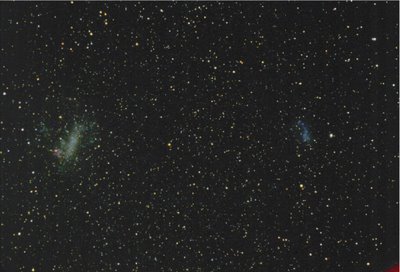Magellanic Clouds

More from the AAS Meeting: A study using Hubble Space Telescope data has shown that the large and small Magellanic Clouds are moving twice as fast in relation to our galaxy as previously thought. Reesearchers took snapshots two years apart to measure their velocity against distant quasars. The Large Magellanic Cloud (left) is moving at 378 km/sec and the Small Magellanic Cloud (right) at 302 km/sec. This may indicate that our Milky Way is more massive than thought, similiar to how we discovered that "dark" mass exists. It could also indicate that the clouds are not gravitationally bound to the Milky Way.
This image is from Chile's Cerro Tololo Observatory. The clouds are only visible from Southern latitudes, so they were not discovered by Europenas until the time of Magellan. The Southern Sky holds many fascinating mysteries.


6 Comments:
Cool! So many wonderful posts! I'm enjoying catching up on a few missed days.
How do you know dark mass exists?
Until you find some in the lab, it's just as much a speculation as epicycles, caloric and phlogiston.
I recall an good estimate from a decade ago that the mass of dust in the universe increases the mass of the universe by 15% of that of the visible matter like stars and hot gas.
Why should dark matter exist far away and not in the lab or in the solar system?
I'm aware of "direct" evidence for dark matter from lensing of light by large unseen masses, Friedmann's critical density being way higher than the observable density, and galactic rotation curves.
This is just like pointing to the sun and saying it is direct evidence of the earth-centred universe, or pointing to fire and saying it is direct evidence of phlogiston.
Where is the experimental check which confirms the amount of dark matter, or it's nature?
HI Kea, great to see your posts always.
Nige, models say that "dark" mass in clusters is 23.87% of the total and mass in voids 71.62%. Those numbers can change slightly depending on the model. There is predicted to be dark mass in the solar system, which we can find sometime. The COSMOS survey is a step toward finding mass in the voids.
Isn't it beginning to seem kind of obvious that dark matter (and dark energy) are basically the same thing as black holes? Or maybe my brain's not working still today. ;-)
Rae Ann, your brain is working great. Your input is valuable because you have more sense than most scientists. If it has gravity but doesn't give off light, Black Hole is the most logical answer.
The other night I was talking with the head of a Sidewalk Astronomers group. Unlike most cosmologists, he had actually looked through telescopes. He understood all along that Black Holes were common.
Post a Comment
<< Home